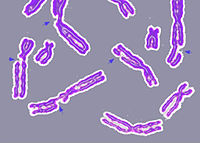
Photo from wikipedia
DNA topoisomerase 1 (TOP11) inhibitors are mainstays of anticancer therapy. These drugs trap TOP1 on DNA, stabilizing the TOP1-cleavage complex (TOP1-cc). The accumulation of TOP1-ccs perturbs DNA replication fork progression,… Click to show full abstract
DNA topoisomerase 1 (TOP11) inhibitors are mainstays of anticancer therapy. These drugs trap TOP1 on DNA, stabilizing the TOP1-cleavage complex (TOP1-cc). The accumulation of TOP1-ccs perturbs DNA replication fork progression, leading to DNA breaks and cell death. By analyzing the genomic occupancy and activity of TOP1, we show that cells adapt to treatment with multiple doses of TOP1 inhibitor by promoting the degradation of TOP1-ccs, allowing cells to better tolerate subsequent doses of TOP1 inhibitor. The E3-RING Cullin 3 ligase in complex with the BTBD1 and BTBD2 adaptor proteins promotes TOP1-cc ubiquitination and subsequent proteasomal degradation. NEDDylation of Cullin 3 activates this pathway, and inhibition of protein NEDDylation or depletion of Cullin 3 sensitizes cancer cells to TOP1 inhibitors. Collectively, our data uncover a previously unidentified NEDD8–Cullin 3 pathway involved in the adaptive response to TOP1 inhibitors, which can be targeted to improve the efficacy of TOP1 drugs in cancer therapy.
Journal Title: Science Advances
Year Published: 2022
Link to full text (if available)
Share on Social Media: Sign Up to like & get
recommendations!